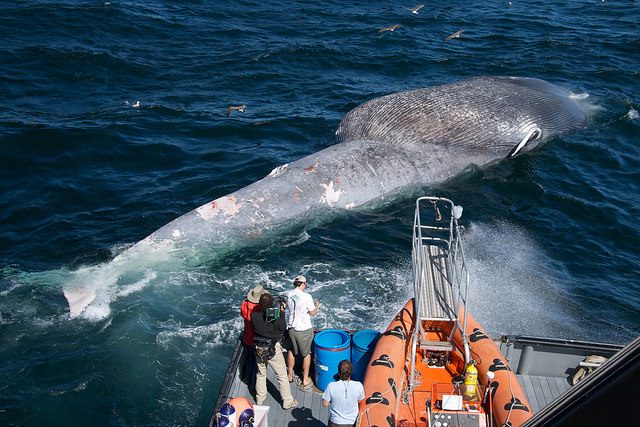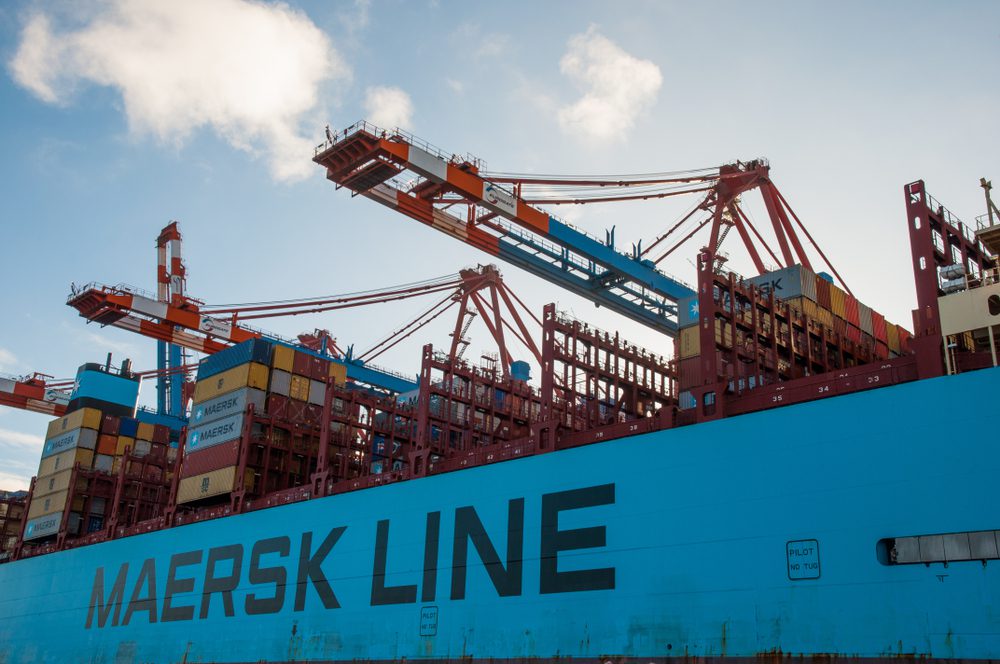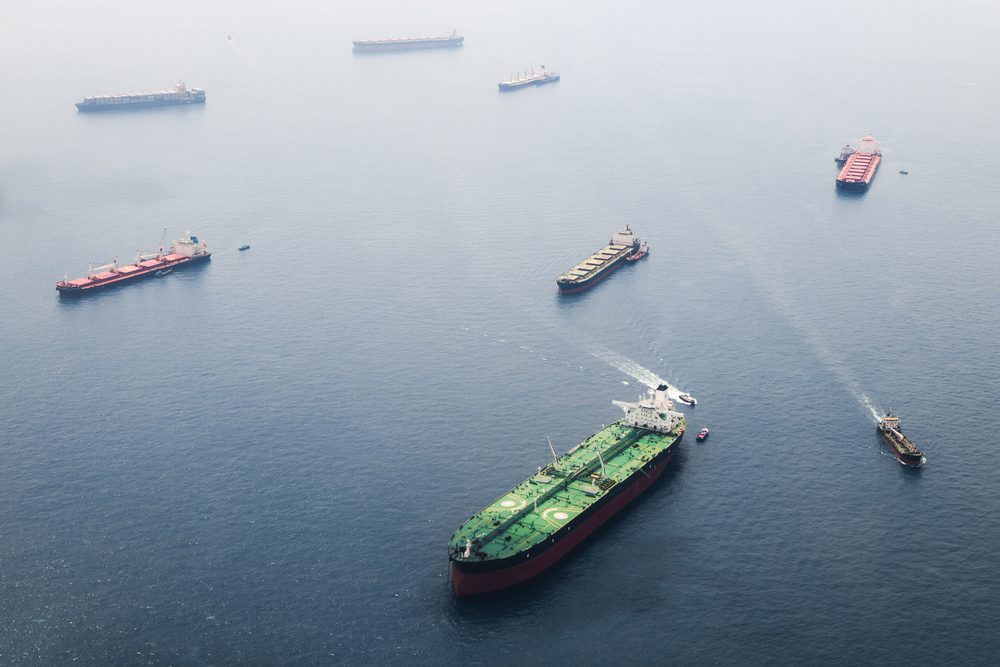Researchers investigate a blue whale believed to have been hit by a ship. The study tracked 171 blue whales fitted with satellite transmitters. Photo courtesy OSU
Blue whales off the West Coast of the United States are under an increased threat of injury and mortality from ship strikes and only slight changes in shipping lanes could be a huge boon for whale safety, a comprehensive 15-year analysis conducted by Oregon State University has found.
The analysis tracked the movements of satellite-tagged blue whales off the U.S. West Coast and found that their favored feeding areas are bisected by heavily used shipping lanes, which has led to the increased threat.
The researchers note that moving the shipping lanes off Los Angeles and San Francisco to slightly different areas, at least, during summer and fall when blue whales are most abundant, could significantly decrease the probability of ships striking the whales. A similar relocation of shipping lanes in the Bay of Fundy off eastern Canada lowered the likelihood of vessels striking endangered right whales an estimated 80 percent.
Results of the study, which was supported by the Office of Naval Research, the National Geographic Society, the National Science Foundation, private gifts to the Oregon State University Marine Mammal Institute and others, are being published this week in the journal PLOS ONE.
The analysis is the most comprehensive study of blue whales movements ever conducted. It was led by researchers at Oregon State University’s Marine Mammal Institute, who tracked the movement of blue whales off the West Coast to identify important habitat areas and environmental correlates, and subsequently to understand the timing of their presence near major ports and shipping traffic.
“The main areas that attract blue whales are highly productive, strong upwelling zones that produce large amounts of krill – which is pretty much all that they eat,” said Ladd Irvine, a researcher with OSU’s Marine Mammal Institute and lead author on the PLOS ONE study. “The whales have to maximize their food intake during the summer before they migrate south for the winter, typically starting in mid-October to mid-November.”
“It appears that two of their main foraging areas are coincidentally crossed by shipping lanes,” Irvine added.
For the study, the researchers attached transmitters to 171 blue whales off California at different times between 1993 and 2008 and tracked their movements via satellite. The study then looked at seasonal as well as individual differences in whale distribution, documenting a high degree of variability, but also a strong fidelity to the upwelling zones that coincide with ship traffic to and from the major ports of Los Angeles and San Francisco.
Blue whales can grow to the length of a basketball court, weigh as much as 25 large elephants combined, and their mouths could hold 100 people, though their diet is primarily small krill. The blue whale is the largest creature to ever inhabit the Earth, yet little was known about their range or where they went to breed until Oregon State’s Bruce Mate led a series of tracking studies featured in the popular 2009 National Geographic documentary, “Kingdom of the Blue Whale.”
An estimated 2,500 of the world’s 10,000 blue whales spend time in the waters off the West Coast of the Americas and are known as the eastern North Pacific population. The huge whales can travel from the Gulf of Alaska all the way down to an area near the equator known as the Costa Rica Dome.
The majority of the population spends the summer and fall in the waters off the U.S. West Coast, with the areas most heavily used by the tagged whales occurring off California’s Santa Barbara and San Francisco, which puts them in constant peril from ship strikes.
“During one year, while we were filming the documentary, five blue whales were hit off of southern California during a seven-week period,” said Mate, who directs the Marine Mammal Institute at OSU’s Hatfield Marine Science Center in Newport, Ore. “Blue whales may not be as acoustically aware as species that rely on echolocation to find prey and there is some evidence that the location of the engines in the rear of the ship creates something of an acoustic shadow in front of them, making it hard for whales to hear the ship coming.
“Putting some kind of noise deterrent on the ships isn’t really an option, however,” Mate added. “You don’t really want to drive endangered whales out of their prime habitat and best feeding locations.”
Moving the shipping lanes would not be unprecedented, the researchers note. Scientists brought concerns about right whale ship strikes in the Bay of Fundy to the International Maritime Organization, and the industry led the effort to modify shipping lanes in the North Atlantic more than a decade ago.
Daniel Palacios, also a co-author on the paper and a principal investigator with OSU’s Marine Mammal Institute, said vessel traffic between Santa Barbara and Los Angeles moved south of its current location in the past to comply with the California Clear Air Act, but shifted back to its current location after getting an exemption to the legislation.
“It is not often that research results are so applicable to a policy decision.” Palacios said, “It’s not really our place to make management decisions, but we can inform policy-makers and in this case it is pretty straightforward. You will eliminate many of the ship strikes on blue whales by moving the shipping lanes south of the northern Channel Islands.”
The solution for the San Francisco area is similar, the researchers note, though not quite as simple. Three separate shipping lanes are used in the region and all cross through the home range and core areas of blue whales tagged in this study.
“We did find that the northernmost shipping lanes crossed the area that was most heavily used by tagged whales,” Irvine noted. “Restricting use of the northern lane during the summer and fall when more whales are present is one option; another would be to extend one lane further offshore before separating it into different trajectories, minimizing the overlap of the shipping lanes with the areas used by blue whales.”
The National Oceanic and Atmospheric Administration is planning a review of shipping lanes in the southern California area, which will be informed by this study. A variety of stakeholders must be consulted, however, before any changes are implemented.

 Join The Club
Join The Club











